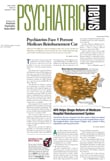Talking with clinicians at the Alaska Native Medical Center’s behavioral health services department (see
story above) gives one the impression that caring for patients there is not all that different from caring for patients in any community mental health center.
For instance, the center’s patient population includes children, adolescents, adults, and families, Robert Wald, M.D., a psychiatrist working in the department, told Psychiatric News.
“I see a lot of emotional problems, anxiety and depression, a lot of behavioral problems, some learning problems, a lot of attention-deficit/hyperactivity disorder,” Kerry Ozer, M.D., another psychiatrist working in the department, said. “A small percentage have bipolar disorder or schizophrenia. I have some children who have autism and Asperger’s disorder. We actually see the full range.”
“There are a lot of balls in the air all at once—community mental health is always busy,” commented Kevin O’Leary, Psy.D., the department’s clinical supervisor of adolescent and adult services.
But working in the department also presents some rather unique challenges. One is “dealing with patients who have just come to Anchorage from the bush and who are not used to city-type ways, such as keeping doctor appointments,” Wald said.
Another is dealing with “the intergenerational transmission of trauma, which is common among Alaska Natives,” O’Leary added. For instance, a generation or two ago the children of Alaska Natives were taken away from their parents and put in Caucasian boarding schools, and these youngsters not only experienced trauma but also passed their psychological distress on to their own children and grandchildren. Depression and anxiety may be the result.
“Some of the patients have severe problems, and they are not always easy to help, to work with,” Ozer explained. “It is probably complicated somewhat by my being of a different race. I’m Caucasian. And the patients here all have some native heritage, and many have all native heritages. So engaging them and getting them to trust me is certainly one of the challenges.”
Also, “many of our patients have Axis I or Axis II disorders with substance abuse problems,” O’Leary said. “So we are trying to beef up our dual-diagnosis services, find ways to integrate these services into our clinic.”
Yet along with the challenges of working in the center’s behavioral health services department come rewards. For instance, the community mental health center in California where O’Leary worked for a while “certainly did not look like this one,” O’Leary admitted. “The environment here is not just pleasurable for us clinicians, but sends a message to patients that they are valued.”
“One of the things I like about working in the department,” Wald said, “is learning a great deal about the Alaska-Native culture without having to go out into the bush. I also enjoy watching the center grow and watching young Alaska Natives being trained at the center.”
Ozer said that the gratification that he receives from working with young patients in the department is much the same that he would receive by working with young patients anywhere. “As they feel better and function better, as their lives improve, as they get excited about their futures, that’s pretty exciting to see.”
In contrast, he continued, there is one thing at the Alaska Native Medical Center that makes his work there very special, and that is the Pathway Home.
“The Pathway Home,” he explained, “is a residential program for native children who have emotional problems and often substance abuse problems. They can stay there anywhere from 18 months to two years. It provides schooling and psychosocial services; it engages family members in therapy. It is really a ‘timeout’ to let children develop the skills they need to return home, to return to the community, to get back on a normal developmental track. I am really thrilled that the center includes that option for my patients.” ▪
